Tibetan Art
T
he golden temple at Bylakkuppe is a great place to see the Tibetan art up close. If you are lucky, you can even see the monks creating those at the temples and Monasteries.Originally the home to the Hindu kings of Chalukya dynasty of Kalyani (10 -11 century CE) , Bijapur was later ruled by various Muslim Sultanates.
During the late 13th century CE Bijapur came under Khilji dynasty, the sultanate that ruled north India from Delhi. Later Bahmani Sultanate of Gulbarga captured Bijapur . Bahmani Sultanate later disintegrated into five separate Sultanates called the Deccani Sultanates. Bijapur was one of them and flourished during the Adil Shahi dynasty (1490-1686 CE). Most of the architectural highlight of Bijapur was built during this dynasty. Subsequently the place was under the rules of the Mugal Empire, Nizam of Hyderabad, the Marathas, the British East India Company and post independence became the headquarters of the Bijapur district of Karnataka State.
Bijapur is a walled city with plenty of military, religious and palatial structures of the bygone era. This erstwhile sultanate capital is known for its architectural splendors, especially the Deccani version of Islamic style architecture.
The most significant is Gol Gumbaz, the tomb of Mohammed Adil Shah. It is the second largest dome of its kind in the world. Gol Gumbaz is known for its acoustical peculiarities.
Ibrahim Rauza (or Ibrahim Roza), the tomb of Ibrahim Adil Shah II, is built on a monolithic rock bed. It's believed that the design of Taj Mahal, built by Shah Jahan of Mugal Empire, was influenced by the design of Ibrahim Rauza thanks to its pleasant symmetry and architectural features.
The largest medieval cannon in the world, Malik-e-Maidan (monarch of the battle field) , is now resting in Bijapur. The cannon is both a piece of art and metallurgical marvel. The nozzle of it is fashioned like a roaring lion and its fang with depiction of crushing an elephant.
Upri Buruj also known, as Hyder Burj is an 80-meter bastion on which two large guns of the past battles are located. The spiraling stairs gives access to the top.
Chand Bawdi is a giant tank of architectural merit built by Ali Adil Shah during the 16th century CE. This was probably the part of a recreational pavilion of the royals or that of a public water supply infrastructure.
Though not completed, Bara Kaman is the mausoleum built by Mohammed Adil Shah. The monument is noted for many architectural features like giant wells and the arches (Bara Kaman means 12 arches in Urdu).
The complex was used as the 'Hall of Justice' and also believed to have housed hairs from Prophet's beard.
Gagan Mahal or the Sky Palace is impressive with its wooden pillars. It's believed that the last king of the Adil Shahi dynasty, Sikandar Adil Shah, surrendered to Aurangzeb, the Mugal Empire in this building.
Other monuments of note in Bijapur are Kudal Sangam (a popular old pilgrimage centre near Bijapur), Gajanan Temple (a modern temple dedicated to the elephant headed god - Ganesha), Alimatti Dam (though not a monument, tourists visit this site to see the hydro project ), Siddeswar Temple ( the Siva temple with interesting architecture), Toravi Narashinha Temple ( the ancient temple dedicated to Narashinha , the half lion-man incarnation of Vishnu ), Jamia Masjid (one of the finest and Mosques in Bijapur built by Ali Adil Shah ), Sangeeta Mahal ( located in Toravi , the ruins of a palace thought to be the royal court for music and dance; also the venue for the annual classical music concert - Navaraspur Music Festival (Jan-Feb) ); Basavan Temple (located in Bagewadi (43km from Bijapur) is noted for the bull temple; Taj Bawadi ( a monumental well with arches and step ways dedicated to the queen Taj Sultana of Adil Shah ); Anand Mahal ( a two storied mausoleum built by Adil Shah); Golgumaz Museum (exhibits various relics of Chalukya and later periods).
Bijapur is accessible by road and rail. Bus connections are frequent more options than rail connections. Though many trains connect Bijapur, one has to reach one of the transit stations near Bijapur to catch many of the of long distance trains : Solapur or Hotgi Jn for Mumbai and Hyderabad; Gadag for Vasco da Gama, Hubli and Hospet.
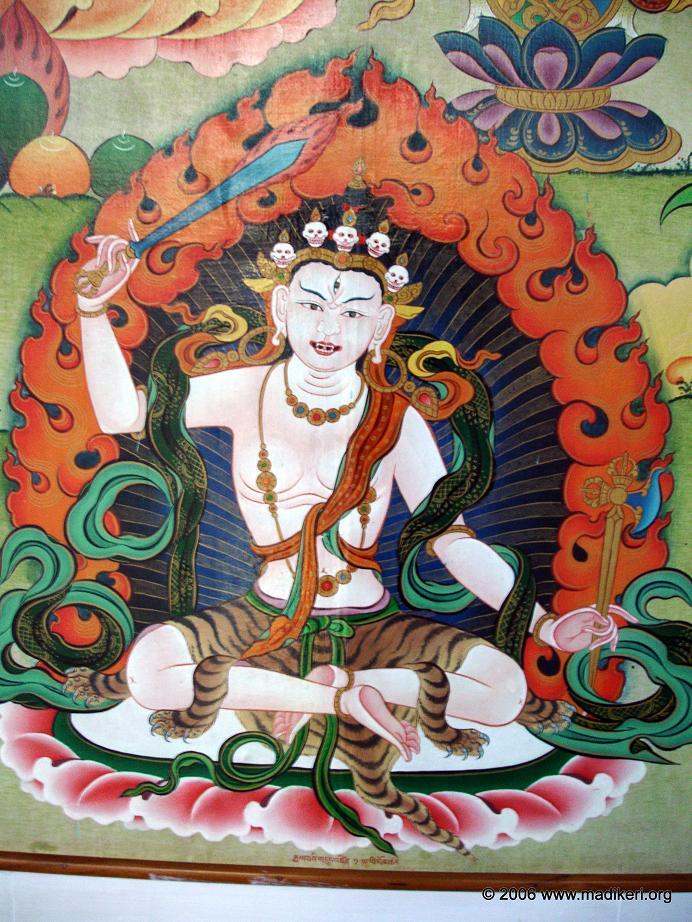
Tibetan art
Tibetan art
 Buland Darwaza at Fatehpursikri[/caption]
This gate is a perfect emblem of the grandeur of the Mughal empire during Akbar’s reign.
The Fatehpur Sikri – Buland Darwaza stands on the highest point of a ridge, its height is 40.84 m and the platform on which it is built is 13.52 m in height. It has a layout plan that is semi octagonal which is similar to many Islamic structures.
[caption id="attachment_649" align="alignleft" width="800"]
Buland Darwaza at Fatehpursikri[/caption]
This gate is a perfect emblem of the grandeur of the Mughal empire during Akbar’s reign.
The Fatehpur Sikri – Buland Darwaza stands on the highest point of a ridge, its height is 40.84 m and the platform on which it is built is 13.52 m in height. It has a layout plan that is semi octagonal which is similar to many Islamic structures.
[caption id="attachment_649" align="alignleft" width="800"]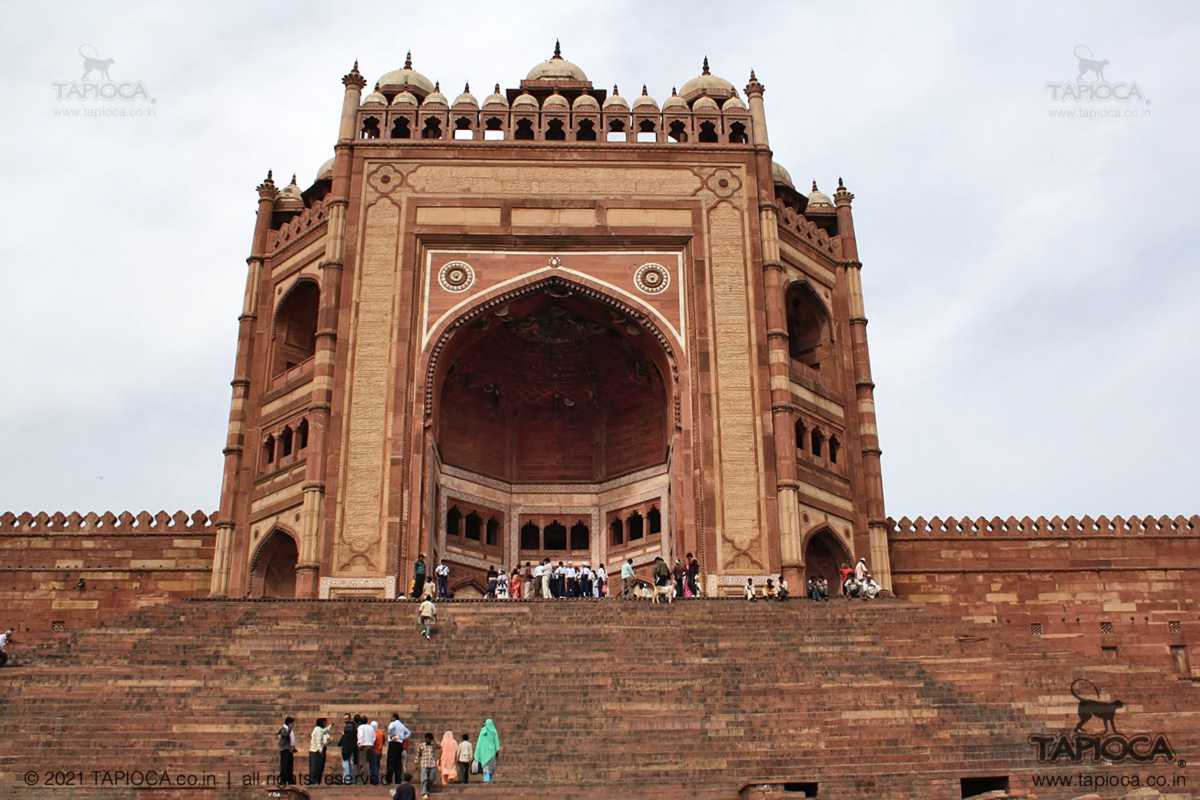 Buland Darwaza at Fatehpur sikri[/caption]
There are two three storeyed wings on both sides of the main gate. The archway in the centre is richly decorated with band of broad yellow buff sandstone. The borders are of panels of red sandstone and on the bottom there are two square panels on both sides with black and white inlay work of marble.
[caption id="attachment_658" align="alignleft" width="800"]
Buland Darwaza at Fatehpur sikri[/caption]
There are two three storeyed wings on both sides of the main gate. The archway in the centre is richly decorated with band of broad yellow buff sandstone. The borders are of panels of red sandstone and on the bottom there are two square panels on both sides with black and white inlay work of marble.
[caption id="attachment_658" align="alignleft" width="800"]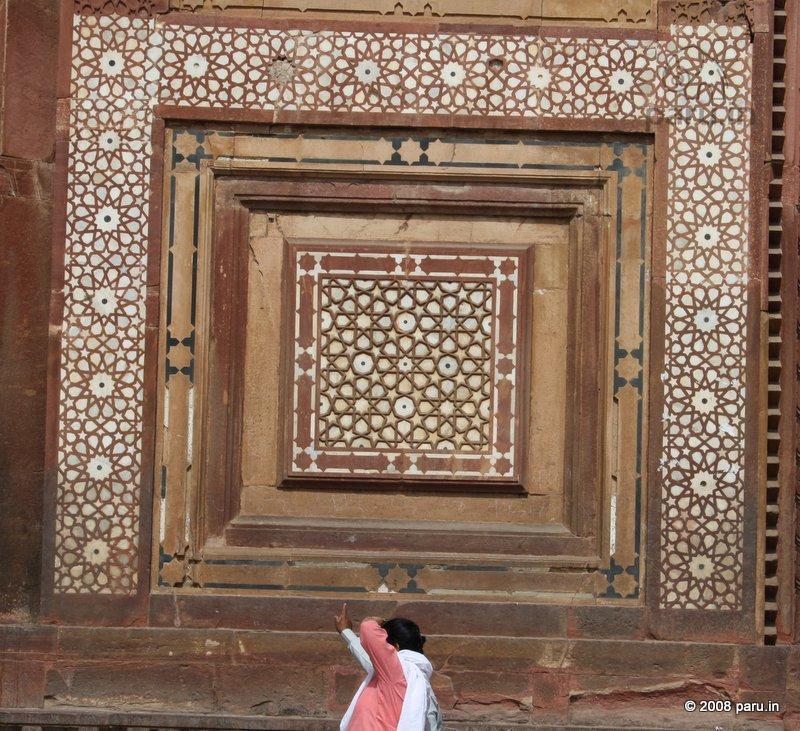 Fatehpur sikri outside Buland Darwaza[/caption]
The pattern of the arch is very similar to that of the Jama Masjid. There are three kiosks on the top surrounded with smaller domed kiosks which are thirteen in number. There are smaller turrets which surround the gateway and increase its magnificence to a great extent.
There are three actual openings bordered by decorative panels and three other arched openings superimposed on it which have a semi dome on top.">
Fatehpur sikri outside Buland Darwaza[/caption]
The pattern of the arch is very similar to that of the Jama Masjid. There are three kiosks on the top surrounded with smaller domed kiosks which are thirteen in number. There are smaller turrets which surround the gateway and increase its magnificence to a great extent.
There are three actual openings bordered by decorative panels and three other arched openings superimposed on it which have a semi dome on top.">
The Buland Darwaza (gateway) at Fatehpur Sikri or was built to commemorate Akbar’s victory and subjugation of the Deccan.
It is one of the highest gateways in the world and is a splendid example of the beauty of Mughal architecture. This gate provides an entrance into the courtyard around the Jama Masjid mosque at Fatehpur Sikri. This gate was built in the year 1601 and till date stands tall and in very good condition.
[caption id="attachment_612" align="alignleft" width="800"] Buland Darwaza at Fatehpursikri[/caption]
Buland Darwaza at Fatehpursikri[/caption]
This gate is a perfect emblem of the grandeur of the Mughal empire during Akbar’s reign.
The Fatehpur Sikri – Buland Darwaza stands on the highest point of a ridge, its height is 40.84 m and the platform on which it is built is 13.52 m in height. It has a layout plan that is semi octagonal which is similar to many Islamic structures.
[caption id="attachment_649" align="alignleft" width="800"] Buland Darwaza at Fatehpur sikri[/caption]
Buland Darwaza at Fatehpur sikri[/caption]
There are two three storeyed wings on both sides of the main gate. The archway in the centre is richly decorated with band of broad yellow buff sandstone. The borders are of panels of red sandstone and on the bottom there are two square panels on both sides with black and white inlay work of marble.
[caption id="attachment_658" align="alignleft" width="800"] Fatehpur sikri outside Buland Darwaza[/caption]
Fatehpur sikri outside Buland Darwaza[/caption]
The pattern of the arch is very similar to that of the Jama Masjid. There are three kiosks on the top surrounded with smaller domed kiosks which are thirteen in number. There are smaller turrets which surround the gateway and increase its magnificence to a great extent.
There are three actual openings bordered by decorative panels and three other arched openings superimposed on it which have a semi dome on top.
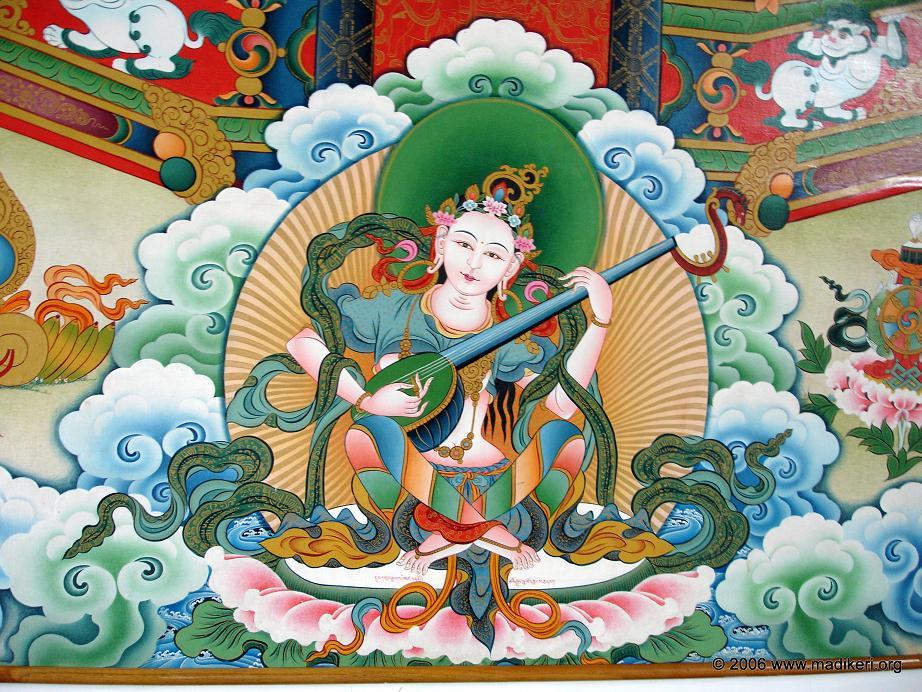
Tibetan art
Tibetan art
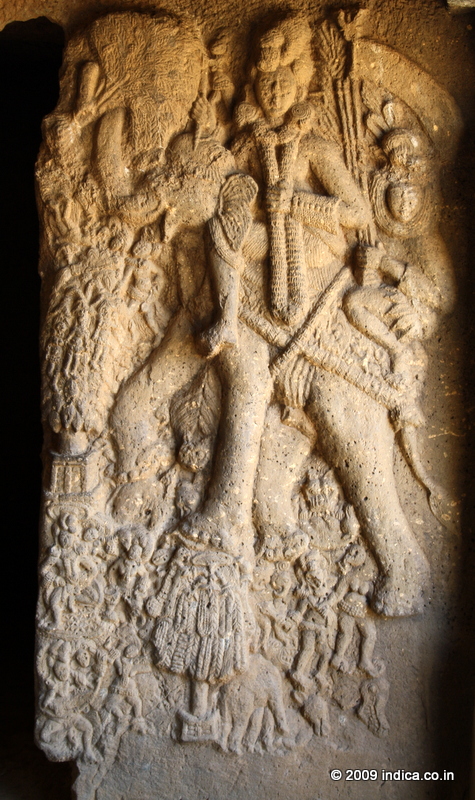 India riding the white called Airavata:
India riding the white called Airavata:In the veranda of the Cave 19 of the Bhaja Caves you'll find one of the earliest picturisation of Indra , the lord of Gods. This probably dates back to 2nd century BC.[/caption] [caption id="attachment_1384" align="alignleft" width="721"]
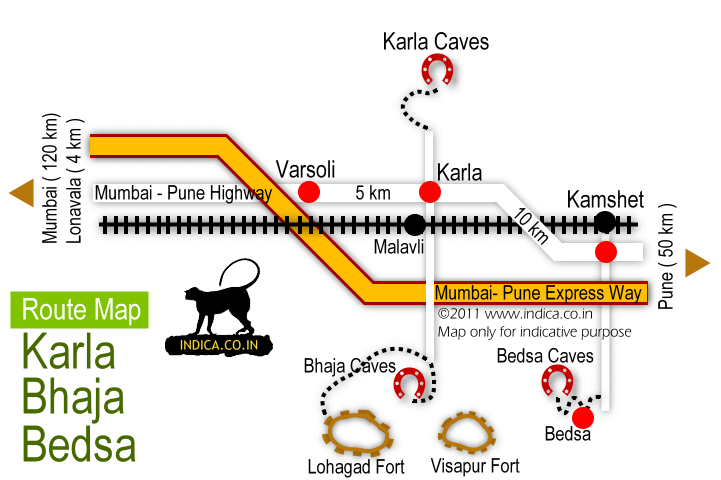 Route map to Bhaja,Karla and Bedse from Kamshet on Mumbei-Pune Express way[/caption]
[caption id="attachment_1389" align="alignleft" width="1024"]
Route map to Bhaja,Karla and Bedse from Kamshet on Mumbei-Pune Express way[/caption]
[caption id="attachment_1389" align="alignleft" width="1024"]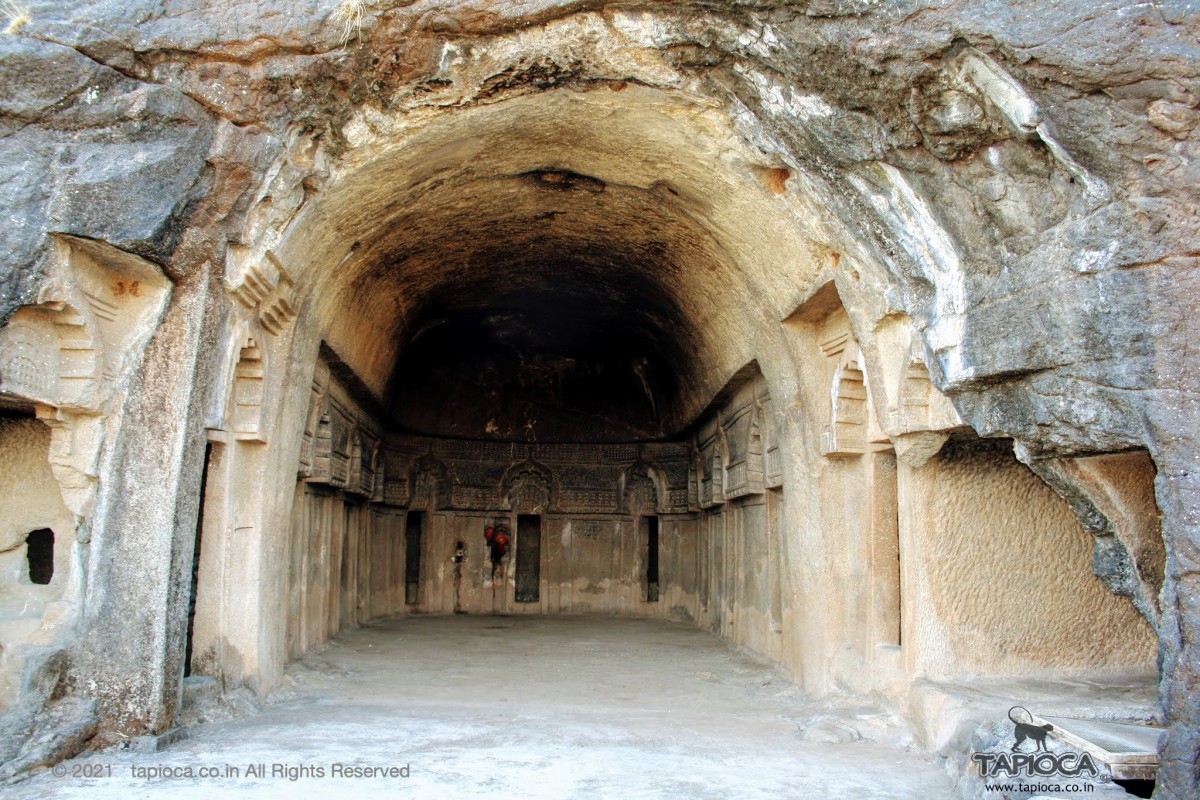 Fine example of the rock cut archetecture[/caption]">
Fine example of the rock cut archetecture[/caption]">
Dating back to 200 BC , Bhaja Caves are located in near Lonavala in Maharashtra. There are about 22 caves located at various levels on the rocky mountain . A group of 14 Stupas , most of them in rows next to each other is peculiar.
[caption id="attachment_2917" align="alignleft" width="475"] India riding the white called Airavata:
India riding the white called Airavata:
In the veranda of the Cave 19 of the Bhaja Caves you'll find one of the earliest picturisation of Indra , the lord of Gods. This probably dates back to 2nd century BC.[/caption]
[caption id="attachment_1384" align="alignleft" width="721"] Route map to Bhaja,Karla and Bedse from Kamshet on Mumbei-Pune Express way[/caption]
Route map to Bhaja,Karla and Bedse from Kamshet on Mumbei-Pune Express way[/caption]
[caption id="attachment_1389" align="alignleft" width="1024"] Fine example of the rock cut archetecture[/caption]
Fine example of the rock cut archetecture[/caption]
